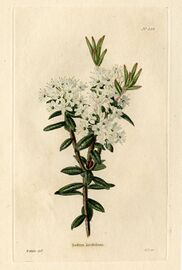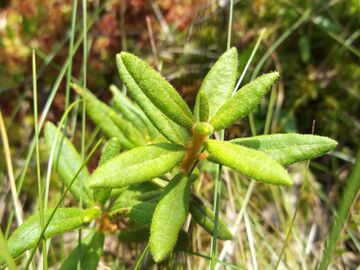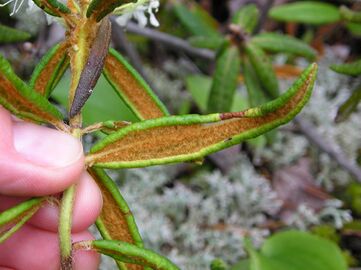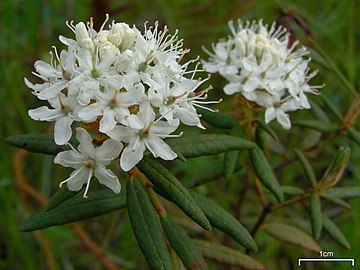Biology:Rhododendron groenlandicum
| Rhododendron groenlandicum | |
|---|---|

| |
| Scientific classification | |
| Kingdom: | Plantae |
| Clade: | Tracheophytes |
| Clade: | Angiosperms |
| Clade: | Eudicots |
| Clade: | Asterids |
| Order: | Ericales |
| Family: | Ericaceae |
| Genus: | Rhododendron |
| Subgenus: | R. subg. Rhododendron |
| Section: | R. sect. Rhododendron |
| Subsection: | R. subsect. Ledum |
| Species: | R. groenlandicum
|
| Binomial name | |
| Rhododendron groenlandicum (Oeder) Kron & Judd
| |
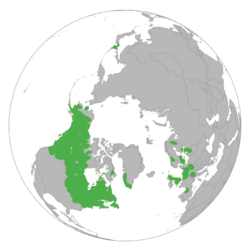
| |
| Distribution of Rhododendrom groenlandicum | |
| Synonyms[1] | |
| |
Rhododendron groenlandicum (bog Labrador tea, muskeg tea, swamp tea, or in northern Canada, Hudson's Bay tea;[2] formerly Ledum groenlandicum or Ledum latifolium)[3] is a flowering shrub with white flowers and evergreen leaves that is used to make a herbal tea.
Description
It is a low shrub growing to 50 centimetres (20 inches) tall—rarely up to 2 metres (6 1⁄2 feet)—with evergreen leaves 2–6 cm (3⁄4–2 3⁄8 in) long and 3–15 millimetres (1⁄8–5⁄8 in) broad. The leaves are wrinkled on top, densely hairy white to red-brown underneath, and have a leathery texture, curling at the edges. The tiny white flowers grow in hemispherical clusters and are very fragrant and sticky.[4]
Distribution and habitat
It is reported from Greenland, as well as from every province and territory in Canada and in the northeastern and northwestern United States (New England, New York, Pennsylvania, Michigan, Wisconsin, Minnesota, Idaho, Washington (state) , and Alaska).
It grows in bogs, muskegs, and open tundra, as well as occasionally on wet shores and rocky alpine slopes.[5][6]
Toxicity
The plant contains toxic alkaloids which are poisonous to livestock and may be toxic to humans in concentrated doses.[6]
Uses
The leaves are regularly used to make beverages and medicines—most commonly a fragrant tea—by many Native American tribes such as the Quinault and Makah, the Potawatomi, the Anishinaabe, the Iroquois, and First Nations tribes in Canada.[6] When European explorers arrived, they soon adopted these uses as well, dubbing it "Indian plant tea".[6] During the American Revolutionary War, it was used as a substitute for tea.[6]
It is sometimes grown as an ornamental shrub.[6]
Its essential oil is popular in aromatherapy.[6]
See also
- Rhododendron (disambiguation)
- List of Rhododendron species
- List of rhododendron diseases
- List of Award of Garden Merit rhododendrons
References
- ↑ "Rhododendron groenlandicum" (in en). Royal Botanic Gardens, Kew. http://www.plantsoftheworldonline.org/taxon/284230-2. Retrieved 27 March 2022.
- ↑ Niering, William A.; Olmstead, Nancy C. (1985). The Audubon Society Field Guide to North American Wildflowers, Eastern Region. Knopf. p. 502. ISBN 0-394-50432-1.
- ↑ Kron, Kathleen Anne; Judd (1990). "Phylogenetic Relationships within the Rhodoreae (Ericaceae) with Specific Comments on the Placement of Ledum". Systematic Botany 15 (1): 67. doi:10.2307/2419016.
- ↑ Peterson, R. T. and McKenny, M. A Field Guide to Wildflowers Northeastern and North-central North America.
- ↑ Kron, Kathleen A.; Judd, Walter S. (1990). "Rhododendron groenlandicum". Systematic Botany (Flora of North America) 15 (1): 57–68. doi:10.2307/2419016. http://www.efloras.org/florataxon.aspx?flora_id=1&taxon_id=250065635.
- ↑ 6.0 6.1 6.2 6.3 6.4 6.5 6.6 Anderson, M. (2011). Plant Guide for bog Labrador tea (Ledum groenlandicum).. Greensboro, NC.: USDA-Natural Resources Conservation Service, National Plant Data Team.. https://plants.usda.gov/DocumentLibrary/plantguide/pdf/cs_legr.pdf.
External links
- USDA PLANTS database: Ledum groenlandicum
- Description of Rhododendron groenlandicum at the American Rhododendron Society
- Photograph of Rhododendron groenlandicum plus description at the Washington Native Plant Society
- Rhododendron groenlandicum at the Connecticut Botanical Society
Wikidata ☰ Q247753 entry
 |
